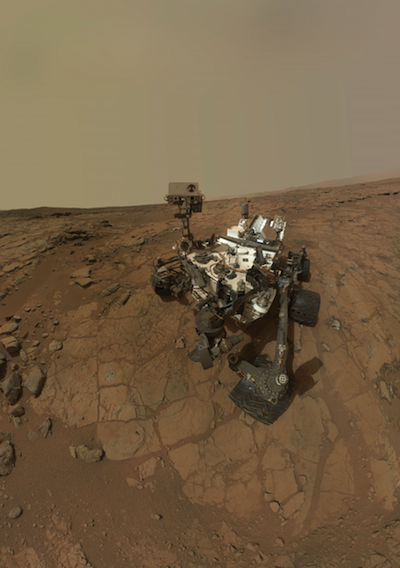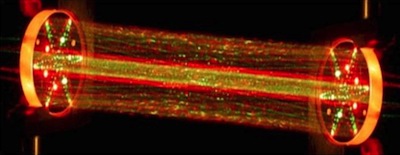
Mars rover gives negative result on Mars methane
BY STEPHEN CLARK
ASTRONOMY NOW
Posted: 23 September 2013

Contrary to earlier measurements from Earth and orbiting sensors, scientists analyzing data from the Curiosity rover have concluded the Martian atmosphere contains no methane, dashing hopes the red planet may still harbor microbial life.

The rover's Mars Hand Lens Imager took dozens of exposures to be compiled into this mosaic self-portrait while Curiosity was stationed at a work site named "John Klein" earlier this year. Credit: NASA/JPL-Caltech/MSSS
The findings, reported Thursday in the journal Science Express, are based on analyses of six samples collected by Curiosity's tunable laser spectrometer inside the nuclear-powered rover's Sample Analysis at Mars, or SAM, instrument, the largest of 10 science instruments carried aboard Curiosity.
The SAM payload ingested Martian air six times from October 2012 through June, passing gas through a chamber illuminated by infrared lasers to check the atmosphere's chemical make-up for methane - a molecule formed by binding one carbon atom to four hydrogen atoms.
NASA says the lack of methane detected by Curiosity, coupled with the spectrometer's sensitivity, bracket the lower limit for the Martian atmosphere's methane concentration at no more than 1.3 parts per billion.
Ground telescopes and Europe's Mars Express orbiter collected data indicating methane's presence in the Martian atmosphere, an indication of current microbial life or undiscovered geologic activity - the two most likely sources of methane.
"It would have been exciting to find methane, but we have high confidence in our measurements, and the progress in expanding knowledge is what's really important," said the report's lead author, Chris Webster of NASA's Jet Propulsion Laboratory in Pasadena, Calif. "We measured repeatedly from Martian spring to late summer, but with no detection of methane."

This picture shows a lab demonstration of the measurement chamber inside the Tunable Laser Spectrometer, an instrument that is part of the Sample Analysis at Mars investigation on NASA's Curiosity rover. This demonstration uses visible lasers - rather than the infrared ones on the actual spectrometer - to show how the lasers bounce between the mirrors in the measurement chamber. Credit: NASA/JPL-Caltech
After initial methane detections from ground-based data in 2003, follow-up observations showed the methane almost completely vanished by 2006, indicating its concentrations could change with Martian seasons.
Curiosity began follow-up methane studies soon after the rover touched down inside Gale Crater on Mars in August 2012. Curiosity's tunable laser spectrometer offers 100 times better spectral resolution than any other instrument tasked with Mars methane research.
"This important result will help direct our efforts to examine the possibility of life on Mars," said Michael Meyer, NASA's lead scientist for Mars exploration. "It reduces the probability of current methane-producing Martian microbes, but this addresses only one type of microbial metabolism. As we know, there are many types of terrestrial microbes that don't generate methane."
Earlier measurements detected localized methane abundances of up to 45 parts per billion, but NASA says Curiosity's data are inconsistent with such concentrations of methane, even if it had dispersed globally.
"There's no known way for methane to disappear quickly from the atmosphere," said one of the paper's co-authors, Sushil Atreya of the University of Michigan, Ann Arbor. "Methane is persistent. It would last for hundreds of years in the Martian atmosphere. Without a way to take it out of the atmosphere quicker, our measurements indicate there cannot be much methane being put into the atmosphere by any mechanism, whether biology, geology, or by ultraviolet degradation of organics delivered by the fall of meteorites or interplanetary dust particles."
Curiosity is not finished with work on the methane question.
Scientists plan more observations to increase the fidelity of the data and seek methane concentrations well below 1 part per billion, according to NASA.
|



